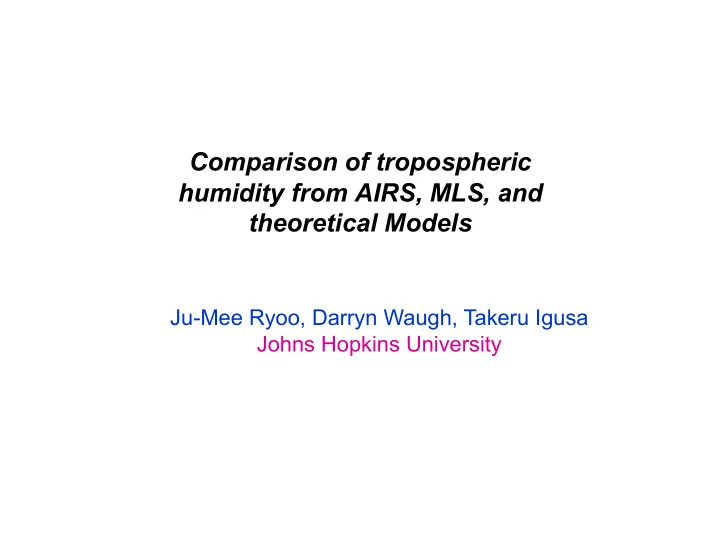

Comparison of tropospheric humidity from AIRS, MLS, and theoretical Models Ju-Mee Ryoo, Darryn Waugh, Takeru Igusa Johns Hopkins University
Introduction • Climate is sensitive to upper tropospheric humidity, and it is important to know distributions of water vapor in this region, and processes that determine these distributions. • We examine the probability distribution functions (PDFs) of upper tropospheric relative humidity (RH) for measurements from Aqua AIRS Aura MLS UARS MLS • Consider spatial variations of PDFs. Focus here on DJF, ~250hPa • Also compare with theoretical models (generalization of Sherwood et al (2006) model).
Climatological UT Relative Humidity DJF (2002-2007) 200-250hPa Mean Relative Humidity (AIRS) Subtropics (15-25N) Tropics (5S-5N) • Subtropics is drier than the Tropics • But also significant zonal variations
PDFs: AIRS 200-250hPa Large variation in PDFs - peak, spread, skewness, … 40E-60E 120E-140E 260E-280E Subtropics (15-25N) similar Different shape Tropics (5S-5N) 0 100 RH (%)
Theoretical Models Basic Assumption: • Moistening by random events • Uniform Subsidence (water is conserved) • t : age (time) of parcel since last saturation
Theoretical Model: Generalized Version As in the Sherwood et al. (2006) model , given uniform subsidence, RH can be approximated as Time since last saturation is now modeled as random moistening events but includes randomness of these events ( k ). Eliminate t from above equations, yields the generalized PDFs of RH as When k=1 it is the same as sherwood et al.(2006) where, : Gamma function r : ratio of drying time ( ) to moistening time ( ) k : measure of randomness of remoistening events
PDFs: Data and Model How well do the theoretical models fit the observed PDFs? 40E-60E 120E-140E 260E-280E Subtropics k>1 (15-25N) (generalized) k=1 (Sherwood) Tropics (5S-5N) Generalized Model can fit the observed PDFs (peak, spread, skewness), with r and k varying with location.
Maps of “r” and “mean RH” AIRS (2002-2007) r µR Strong resemblance between maps of r and mean RH ( µ R )
Maps of “r” and “k” AIRS (2002-2007) r k Convective Regions : large r ( r >1) and small k => Rapid, random remoistening
Maps of “r” and “k” AIRS (2002-2007) r k Non-convective Regions: small r ( r <1) and large k => Slower, more regular remoistening (horizontal transport)
PDFS: AIRS - Aura MLS Comparison 40E-60E 120E-140E 260E-280E Subtropics (15-25N) Tropics (5S-5N) Good agreement between AIRS and Aura MLS, with some exceptions.
Spatial Variations in r r = τ dry / τ moist Subtropics • Good agreement between different (15-25N) data sets. All show r > 1 in tropical convective regions, r < 1 in dry regions. • Expected as larger r implies more rapid remoistening Tropics (5S-5N)
AIRS - Aura MLS bias AIRS MLS Largest difference: Tropical convective regions (5S-5N, 120-140E) • There are some differences between AIRS and MLS PDFs. • Differences are not simply a function of RH. • Is there a simple parameterization of the AIRS-MLS difference?
Bias between data: R MLS /R AIRS R MLS /R AIRS R MLS /R AIRS
AIRS - Aura MLS bias AIRS MLS R MLS /R AIRS 300 Transform R MLS /R AIRS = f(R MLS , OLR ) 2.0 MLS Data OLR 1.5 1 .8 .4 150 100 200 0 R MLS
Conclusions • Several robust features (peak, range, skewness) are found in the observed PDFs from all three data-sets (Aura and UARS MLS, AIRS). • All can be well fit by a generalized version of the Sherwood et al. (2006) theoretical model. • Consistent spatial variations in “r” (ratio of drying and moistening times) and “k” (randomness of moistening process). • Large r , small k in tropical convective regions rapid, random remoistening • Small r , large k in dry regions slow, more regular remoistening • A more quantitative link between the different physical processes and the parameters r and k is needed. This would be performed by trajectory-based water vapor simulations.
Theoretical Model: Sherwood et al (2006) Sherwood et al. (2006) assumed that if parcels uniformly subside, RH can be approximated as Time since last saturation is modeled as time between random moistening events Eliminate t from above equations, yields the PDFs of RH as where, is the uniform drying time by subsidence is the time between remoistening events.
Characteristics of the Gamma PDF k = 1 Gamma PDF= Exponential PDF k > 1 k = 3 k = 10 pdf of X pdf of X RH RH : randomness parameter Large => less random moistening events
Recommend
More recommend